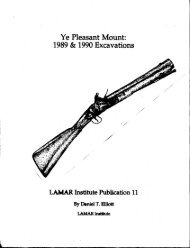Stirring Up a Hornet's Nest: - UGA Laboratory of Archaeology ...
Stirring Up a Hornet's Nest: - UGA Laboratory of Archaeology ...
Stirring Up a Hornet's Nest: - UGA Laboratory of Archaeology ...
Create successful ePaper yourself
Turn your PDF publications into a flip-book with our unique Google optimized e-Paper software.
BOTHER PATRIOTS LINKED TO KETTLE CREEK<br />
Captain John Stephens<br />
John Stephens commanded a company <strong>of</strong> South Carolina militia in 1779. Captain Stephens was apparently<br />
cashiered from military service as a result <strong>of</strong> his poor performance in the expedition against Colonel<br />
Boyd’s regiment. Captain Stephens was probably not directly involved in the battle at Kettle Creek and the<br />
details <strong>of</strong> his court martial remain unknown. Private John Ridgeway served in his company, and he noted in<br />
1833, “In the fall <strong>of</strong> 1779 he [Ridgeway] was drafted for a tour <strong>of</strong> three months and served under Capt.<br />
John Stephens about two months <strong>of</strong> the time when Stephens was cashiered for improper conduct and the<br />
company in consequence <strong>of</strong> the approach <strong>of</strong> the Tories under Col. Boyd dispersed” (Footnote.com 2008<br />
[John Ridgeway S21947]). The present researchers did not pursue Captain Stephen’s story, so his presence<br />
on the battlefield remains undetermined.<br />
Private David Anderson<br />
Private David Anderson, South Carolina militia, did not participate in the battle <strong>of</strong> Kettle Creek, although<br />
he had been in pursuit <strong>of</strong> Colonel Boyd as far as Fort Independence, South Carolina. Anderson stated in his<br />
pension application, that he volunteered for service in 1778, “under Capt. William Mulwee (sic, Milwee)<br />
company <strong>of</strong>ficer and Major John (sic, James) Williams, Col. Brannon (sic, Brandon) field <strong>of</strong>ficers;<br />
marched to Ripley's Fort; from thence went in pursuit <strong>of</strong> one Boyd a Tory; pursued as far as Fort<br />
Independence on Savannah River where we learned Boyd had been captured by Col. Pickens at Kettle<br />
Creek. Hence went in pursuit <strong>of</strong> other Tory parties, returned home after a tour <strong>of</strong> about six weeks.”<br />
(Footnote.com 2008 [David Anderson S6515]).<br />
Private Patrick Cain<br />
Private Patrick Cain, South Carolina militia, was not a participant in the battle <strong>of</strong> Kettle Creek. He was at<br />
Cherokee Ford and participated in the battle at Vann’s Creek days prior to the battle; however Cain<br />
provided these details in 1833,<br />
Again, in the latter part <strong>of</strong> the year 1779 or about the first <strong>of</strong> 1780, I volunteered to defend a fort on the Savannah River, at<br />
the Cherokee Ford, under the command <strong>of</strong> Lieutenant Shankland. This fort was deemed <strong>of</strong> considerable importance,<br />
particularly against the Tories, who at that time had collected to the number <strong>of</strong> about 700 men under Col. Boyd Moore, in the<br />
back parts <strong>of</strong> South Carolina, and was marching to Augusta or Savannah. Gen. Pickens was then at the head <strong>of</strong> a body <strong>of</strong><br />
militia, and stationed himself at Cedar Island on the Savannah about eight miles below the fort in order to intercept them.<br />
The Tories approached near the fort and sent in a flag, and asked permission to pass the ford, which if granted, they would<br />
not attack the fort but Shankland returned for answer that he was able to defend the fort and ford both. Colonel Little being<br />
apprized <strong>of</strong> the intention <strong>of</strong> the Tories to force a passage at the ford, sent in reinforcement, which I supposed deterred the<br />
Tories from attempting a passage, and they turned their course up the river in order to cross at the mouth <strong>of</strong> Van's Creek. To<br />
prevent this, Captains Millin M. Baskin and Anderson, with about 100 men were detached across the river, and marched up<br />
to the mouth <strong>of</strong> Van's Branch, and opposed their passage. I was now again under Captain Anderson. Before we reached the<br />
place, the greater part had crossed but we immediately began the attack which continued over an hour, by which time the<br />
remaining Tories had crossed over and reinforced the others. We then gave way and retreated in some confusion, having lost<br />
one killed and 18 prisoners. We organized the Fort in a short time after this, Gen. Pickens defeated these same Tories at<br />
Kettle Creek. I served in this fort and at this time two months and was discharged (Footnote.com 2008 [Patrick Cain<br />
S1185]).<br />
Private Marshall Frank<br />
Private Marshall Frank served in Colonel Leroy Hammond’s regiment <strong>of</strong> South Carolina militia and he did<br />
not participate in the battle <strong>of</strong> Kettle Creek. Private Franks did, however, was involved in the aftermath <strong>of</strong><br />
the battle when he captured two <strong>of</strong> the fleeing Loyalist participants, Ensign Aquilla Hall and Hector<br />
McNeal. The capture happened after Franks became separated from the rest <strong>of</strong> his regiment during the<br />
battle <strong>of</strong> Briar Creek in early March, 1779. In 1836 at age 84, Franks described their capture and their<br />
march to Ninety-Six, or Cambridge, South Carolina:<br />
76










